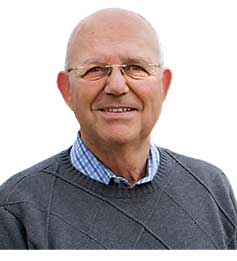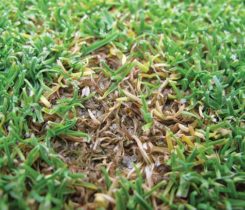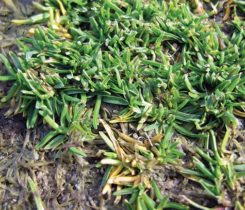The truth about anthracnose

Mike Kenna
A favorite television show of mine was MythBusters, hosted by Jamie Hyneman and Adam Savage. I enjoyed watching the two interact on how to run experiments testing the validity of rumors, myths and adages. They stamped the outcome of the myths tested as busted, plausible or confirmed.
Each year, we made annual visits to all USGA Green Section research projects. A few committee members, Green Section staff and I would travel to different universities. We would listen to a summary about the previous year’s results. Then, we were off to the lab, greenhouse or turfgrass plots to see the research progress for ourselves. Some of the research busted myths. That is why I love the scientific method — you get to test concepts under controlled conditions. Experiments reveal the truth.
Busting myths never was so dramatic as the anthracnose (Colletotrichum cereale) research on annual bluegrass (Poa annua). In the 1990s, this disease was damaging annual bluegrass greens throughout the northern U.S.
Myth busters Bruce Clarke, Ph.D. and James Murphy, Ph.D., proposed research to test cultural practices thought to cause or prevent the disease. The two scientists and their supporting cast of graduate students busted one myth after another. A crew of additional university researchers in the Northeast made contributions to the development of best management practices (BMPs) for the disease. The following are a few myths investigated.
Myth 1
Anthracnose severity increases with sand topdressing.
BUSTED. Light, frequent topdressing decreased anthracnose, especially at lower cutting heights. Topdressing with sand throughout the growing season also provides firm and fast playing conditions for the golfer. Biweekly applications of 100 pounds of sand per 1,000 square feet during the summer playing season reduced anthracnose severity significantly.
Myth 2: Fertilizer applications increase disease severity.
BUSTED. Avoiding nitrogen (N) and potassium (K) deficiencies were critical in preventing anthracnose. Weekly, light-rate applications of 0.1 to 0.2 pound of N per 1,000 square feet reduced disease severity. But, weekly applications of 0.3 pound of nitrogen per 1,000 square feet was too much. Anthracnose was more severe when potassium dropped below 50 ppm in the surface two inches of the root zone. Keeping the pH above 6.0 to 6.5 also helped prevent disease severity. Tissue testing of clippings helped dial in a fertilization program that keeps nitrogen around 3.35 percent and potassium above 2.4 percent in the leaf.
Myth 3: Wounding from mowing, rolling and traffic increases anthracnose.
BUSTED. This could be true if you ignore the results busting myth Nos. 1 and 2. Height of cut below 0.125 inch increased plant stress and emphasized attention to fertility and topdressing. Double-cutting greens and lightweight rolling did not increase anthracnose severity and should be implemented at the highest possible cutting height to obtain the desired green speed.
Myth 4: A preventive fungicide program is necessary.
BUSTED. The effectiveness of fungicides tested improved with proper fertility and light sand topdressing. The curative fungicide approach provided adequate control and reduced the annual amount needed. Reducing fungicide use saved money and also reduced the risk of anthracnose resistance to products.
Clarke and Murphy conducted a logical, stepwise list of experiments to test the impact of daily cultural practices on the severity of anthracnose. By providing healthy, less stressful growing conditions, the severity of anthracnose on annual bluegrass decreased. Clarke admitted on one visit he never thought a curative fungicide program would control anthracnose. Yet, that year, they only made four fungicide applications.
Turfgrass managers are very fortunate to have great scientists at land grant universities to bust myths. The USGA, GCSAA and other associations have helped pay the bills. What myths do you want to see busted?












